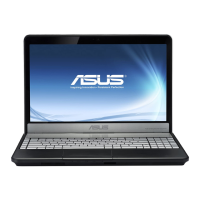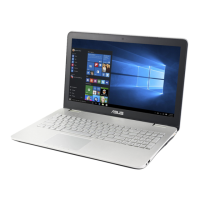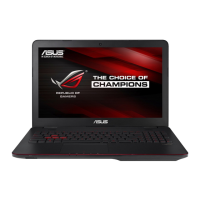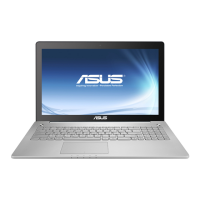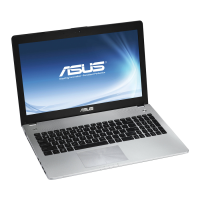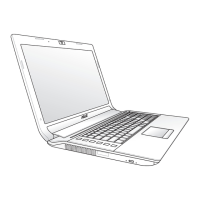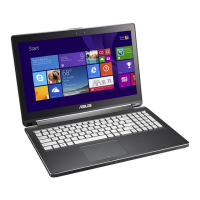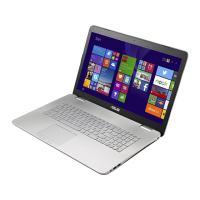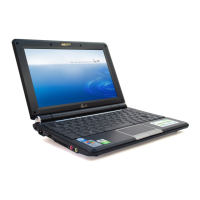Do you have a question about the Asus N55SF and is the answer not in the manual?
Introduces the manual's content and structure for understanding the notebook.
Explains the meaning of symbols and text conventions used throughout the manual.
Lists critical safety guidelines for operating and handling the notebook to prevent hazards.
Provides step-by-step instructions for initial setup, including battery installation and AC adapter connection.
Identifies and describes the microphone, camera, display, and keyboard on the notebook's top surface.
Details components on the bottom, including battery lock, maintenance compartments, and vents.
Describes the various ports and connectors found on the right and left sides of the notebook.
Explains the battery pack location (back) and status indicators (front).
Covers AC adapter use, battery charging, power options, and power management settings.
Explains keyboard usage, including special function (hot) keys and Windows keys.
Details the function of physical buttons, switches, and LED status indicators on the notebook.
Guides on using the touchpad for cursor control, selection, scrolling, and gestures.
Information on optical drives, flash memory card readers, and hard disk drives.
Instructions for connecting to wired networks, Wi-Fi, and related settings.
Steps for pairing and connecting Bluetooth-enabled devices like phones or peripherals.
Explains how to use USB ports to charge external devices, even when the notebook is off.
Solutions for common hardware issues like optical drive failure or keyboard malfunctions.
Addresses issues like system instability, slow performance, and blue screen errors.
Troubleshooting for problems with bundled software, drivers, and BIOS updates.
Information on the pre-installed OS, supported software, and driver disk usage.
Details on accessing BIOS, changing boot order, and setting passwords.
Explains Blu-ray/DVD playback, region restrictions, and CSS protection.
Information on modem standards, FCC statements, CE marking, and wireless regulations.
Contains copyright information, limitation of liability, and details on contacting ASUS support.
Introduces the manual's content and structure for understanding the notebook.
Explains the meaning of symbols and text conventions used throughout the manual.
Lists critical safety guidelines for operating and handling the notebook to prevent hazards.
Provides step-by-step instructions for initial setup, including battery installation and AC adapter connection.
Identifies and describes the microphone, camera, display, and keyboard on the notebook's top surface.
Details components on the bottom, including battery lock, maintenance compartments, and vents.
Describes the various ports and connectors found on the right and left sides of the notebook.
Explains the battery pack location (back) and status indicators (front).
Covers AC adapter use, battery charging, power options, and power management settings.
Explains keyboard usage, including special function (hot) keys and Windows keys.
Details the function of physical buttons, switches, and LED status indicators on the notebook.
Guides on using the touchpad for cursor control, selection, scrolling, and gestures.
Information on optical drives, flash memory card readers, and hard disk drives.
Instructions for connecting to wired networks, Wi-Fi, and related settings.
Steps for pairing and connecting Bluetooth-enabled devices like phones or peripherals.
Explains how to use USB ports to charge external devices, even when the notebook is off.
Solutions for common hardware issues like optical drive failure or keyboard malfunctions.
Addresses issues like system instability, slow performance, and blue screen errors.
Troubleshooting for problems with bundled software, drivers, and BIOS updates.
Information on the pre-installed OS, supported software, and driver disk usage.
Details on accessing BIOS, changing boot order, and setting passwords.
Explains Blu-ray/DVD playback, region restrictions, and CSS protection.
Information on modem standards, FCC statements, CE marking, and wireless regulations.
Contains copyright information, limitation of liability, and details on contacting ASUS support.
| Bus type | DMI |
|---|---|
| Stepping | J1 |
| Tjunction | 100 °C |
| Processor cache | 3 MB |
| Processor cores | 2 |
| System bus rate | 5 GT/s |
| Processor family | Intel® Core™ i5 |
| Processor series | Intel Core i5-2400 Mobile Series |
| Processor socket | Socket 988 |
| Processor threads | 4 |
| Processor codename | Sandy Bridge |
| Processor frequency | 2.4 GHz |
| Processor cache type | Smart Cache |
| Processor lithography | 32 nm |
| Processor manufacturer | Intel |
| Processor front side bus | - MHz |
| PCI Express slots version | 2.0 |
| Processor boost frequency | 3 GHz |
| Processor operating modes | 64-bit |
| ECC supported by processor | No |
| PCI Express configurations | 1x16, 2x8, 1x8+2x4 |
| Thermal Design Power (TDP) | 35 W |
| CPU multiplier (bus/core ratio) | 24 |
| Maximum number of PCI Express lanes | 16 |
| Motherboard chipset | Intel® HM65 Express |
| HDD size | 2.5 \ |
| HDD interface | SATA |
| Storage media | HDD |
| Optical drive type | DVD Super Multi |
| Card reader integrated | Yes |
| Total storage capacity | 640 GB |
| Compatible memory cards | Memory Stick (MS), MMC, MS PRO Duo, SD |
| Display diagonal | 15.6 \ |
| Display resolution | 1600 x 900 pixels |
| Native aspect ratio | 16:9 |
| Memory slots | 2x SO-DIMM |
| Internal memory | 4 GB |
| Memory clock speed | 1333 MHz |
| Internal memory type | DDR3-SDRAM |
| Maximum internal memory | 8 GB |
| Type | PC |
| LightScribe | - |
| Power supply type | AC/DC |
| Power requirements | 100-240V |
| Wireless technology | Wireless LAN |
| Graphics card family | NVIDIA |
| On-board graphics card ID | 0x116 |
| Discrete graphics card model | NVIDIA® GeForce® GT 555M |
| On-board graphics card model | Intel® HD Graphics 3000 |
| Discrete graphics card memory | 2 GB |
| Discrete graphics memory type | GDDR3 |
| On-board graphics card family | Intel® HD Graphics |
| On-board graphics card base frequency | 650 MHz |
| On-board graphics card dynamic frequency (max) | 1200 MHz |
| Audio system | SonicMaster |
| Keyboard layout | QWERTY |
| Pointing device | Touchpad |
| Wi-Fi standards | 802.11b, 802.11g, Wi-Fi 4 (802.11n) |
| Bluetooth version | 3.0+HS |
| Cabling technology | 10/100/1000Base-T(X) |
| Networking topology | Gigabit Ethernet |
| Operating system installed | Windows 7 Home Premium |
| Charging port type | DC-in jack |
| USB 2.0 ports quantity | USB 2.0 ports have a data transmission speed of 480 Mbps, and are backwards compatible with USB 1.1 ports. You can connect all kinds of peripheral devices to them. |
| Firewire (IEEE 1394) ports | 0 |
| Battery capacity | 5200 mAh |
| Number of battery cells | 6 |
| AC adapter frequency | 50 - 60 Hz |
| AC adapter input voltage | 100 - 240 V |
| AC adapter output voltage | 19 V |
| Product color | Black |
| Processor code | SR04W |
| Processor ARK ID | 53450 |
| Processor package size | 37.5x37.5 (rPGA988B); 31 x 24 (BGA1023) mm |
| Supported instruction sets | AVX |
| Intel Identity Protection Technology version | 1.00 |
| Depth | 261 mm |
|---|---|
| Width | 379 mm |
| Height | 35.5 mm |
| Weight | 2700 g |
